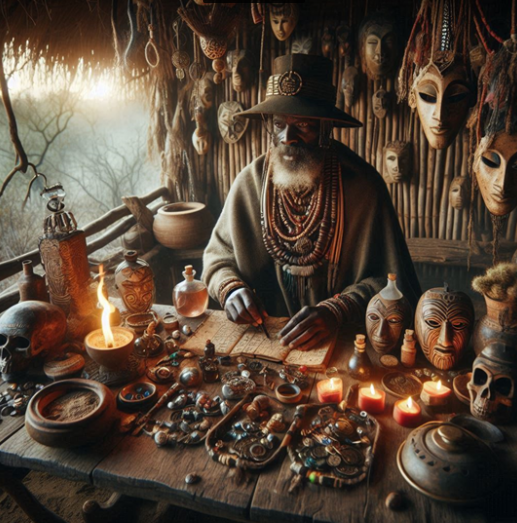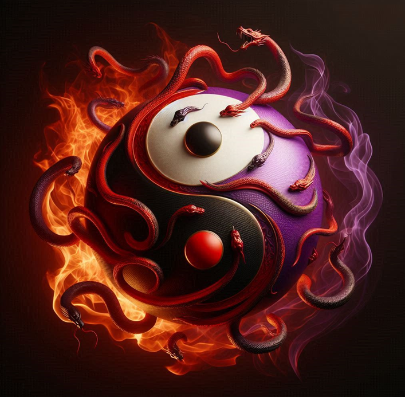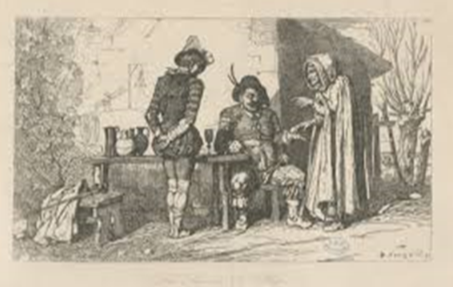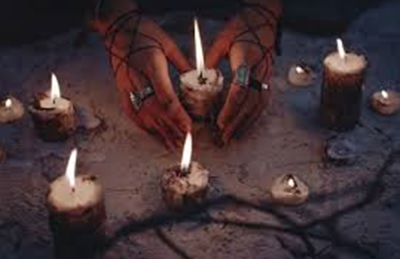Witchcraft and Black Magic :History, Practices, and Malevolent Entities
- Julia Heisler
- Aug 17, 2024
- 8 min read
Author: Corinne RICHARD
Website: https://www.frenchmysticgateway.com
Black magic, witchcraft, and the stereotypical images we have of them have their
roots in a rich historical evolution. Since antiquity, perceptions of magic have evolved,
shaped by religious beliefs and occult practices. This article explores the origins of
black magic, its practices, and how it is perceived today, shedding light on the often-
overlooked nuances.
Origins and Historical Evolution
Black magic, with its various manifestations around the world, has its roots in ancient
practices and deeply rooted beliefs. The historical evolution of black magic was
marked by diverse geographical and religious contexts. Black magic emerged
through primitive cults. From antiquity, civilizations distinguished between beneficial
magic, often associated with the benevolence of deities, and black magic, which was
seen as manipulating divine powers for personal gain. Ancient societies believed that
magical practices could invoke supernatural forces for good or ill, and this dichotomy
has persisted through the ages.
In ancient cultures, magic was often an extension of religion. Acts of witchcraft were
integrated into broader belief systems, and only malicious actions, such as curses,
were condemned by religious and political authorities. During the Renaissance, the
Inquisition attempted to eradicate certain practices.
Witchcraft in Africa
In Africa, witchcraft and occult practices have a long history dating back centuries,
well before the arrival of European colonizers. Traditional African societies believe
that magic can influence the natural world and human relationships. Witchcraft in
Africa is often associated with traditional medicine and spiritual rituals. Witches and
sorcerers, known by various names depending on the region, are important figures in
their communities. They use their knowledge to heal illnesses, bring prosperity, or, in
some cases, cast curses.
Magical practices are often integrated into local religious belief systems. For
example, in West Africa, practitioners may invoke ancestral spirits for guidance or
divine intervention. In this context, black magic is rarely seen as malevolent but
rather as a powerful tool that can be used for protection or vengeance.
Voodoo
Voodoo, an Afro-American religion originating from Haiti, is an emblematic example
of how African beliefs have been integrated and transformed in a new cultural
context. Voodoo combines elements of traditional West African religions with Catholic
Christianity. Voodoo practitioners believe in a hierarchy of spirits or deities called lwa,
who can interact with the world of the living.
In Voodoo, black magic is sometimes used in specific contexts, notably for
community protection or conflict resolution. Rituals may include invoking spirits to
influence behavior or events. Contrary to stereotypical representations, in Voodoo
tradition, black magic is not inherently malevolent but rather a powerful tool that must
be used with caution and respect. A very specific branch of Voodoo magic involves
curses and poisons, including the creation of zombies.
Witchcraft in France : A Historical Anecdote
In France, witchcraft has been a subject of great anxiety and persecution, particularly
during the medieval and Renaissance periods. A famous episode is the case of the
"Witches of Loudun",which took place in the early 17th century. In 1634, several
nuns from a convent in Loudun, a town in western France, were accused of witchcraft
after manifestations of collective hysteria and demonic possession. Priest Urbain
Grandier was accused of having bewitched the nuns, leading to his trial and
execution.
This event illustrates how witchcraft was perceived as a serious threat and how
accusations could lead to tragedies. Witch trials in France were often marked by fear
and ignorance and had devastating repercussions on the lives of the accused.
Black Magic in China
In China, occult practices and black magic have ancient roots in Taoism and
Buddhism. Chinese black magic is associated with the esoteric practices of Taoism,
which include the use of talismans, incantations, and rituals to manipulate spiritual
and natural energies. Sorcerers and practitioners of black magic in China use these
rituals to influence events or harm their adversaries.
A particular form of black magic in China is "shadow magic" or "yin magic" which
involves dark rituals and the manipulation of the spirits of the dead. These practices
are used to obtain answers or interventions in personal or political matters. The term
"yin magic" refers to a branch of magic that uses the principles of yin and yang.
Shadow magic focuses mainly on the yin aspects, involving esoteric practices that
explore occult dimensions and invisible forces.
Practitioners invoke spirits or spiritual entities to gain information or exert influence on
the physical world. The invoked spirits may include ancestors, nature spirits, or
darker entities. These practices are carried out using complex rituals, talismans, and
specific incantations. Yin magic rituals often involve symbolic objects, talismans,
dolls, amulets, or artifacts charged with occult powers. Shadow magic uses rituals to
manipulate invisible energies to disturb a person's energetic balance, cause illness,
or influence events.
Black Magic in Armenia
In Armenia, black magic also has a long history, influenced by pre-Christian traditions
and folk beliefs. Armenian black magic is linked to ancient pagan practices and the
manipulation of supernatural forces for personal ends.
Ancient Armenians believed in spirits and deities that could be appeased or angered
through specific rituals.
Armenian sorcerers use spells and talismans to achieve their goals, invoking
supernatural entities or performing rituals to influence destiny.
Practices and Concepts of Black Magic : The Purpose of Harm
Black magic encompasses a variety of esoteric and occult practices used to harm
others or negatively influence events, seek glory, wealth, or success at the expense
of others. These practices, shrouded in mystery and taboo, include specific
techniques such as necromancy, rituals aimed at bringing misfortune or discord, and
more sinister methods involving personal objects or malevolent entities.
These practices share a common goal : to negatively impact the lives of
targeted individuals.
Necromancy
Necromancy is the art of communicating with the dead, often to obtain hidden
information or influence events using the spirits of the deceased. In black magic,
necromancy is used to manipulate the spirits of deceased individuals for malevolent
purposes. Practitioners use complex rituals to summon spirits and ask them to create
confusion or terror among the living.
Rituals of Misfortune, Illness, and Discord
Black magic rituals can aim to create misfortunes, illnesses, or discord in a person's
life and their surroundings. These practices include:
Rituals of Misfortune : Practitioners use various objects, symbols, and
incantations to attract misfortune to a person. These rituals aim to disrupt daily
life and create unfavorable situations.
Rituals of Illness : Some rituals seek to induce illnesses or physical afflictions
using personal items of the targeted individual, such as hair or nails, combined
with spells and incantations.
Rituals of Discord : These rituals are designed to sow discord and conflict
between individuals. Black magicians use talismans or potions to provoke
disputes and separations within families or social groups.
Sinister Rites and Objects Used
Black magic rituals can also involve particularly sinister and disturbing elements:
The Knot of the Aiguillette : A specific rite in some black magic traditions
involves "tying the aiguillette, a practice intended to prevent a couple from
being happy together. This ritual often involves creating knots with threads or
cords, symbolizing separation and obstacles in the relationship.
Disturbing Objects : Rites may use personal items such as nails, hair, or
excrement. These elements are associated with spells aimed at targeted
harm. For example, nails might be driven into a doll representing the victim to
inflict pain or misfortune.
Black Magic Dolls : Creating dolls or figurines resembling a person is a
classic method of black magic. These dolls are used to inflict pain, illness, or
curses by manipulating them as replicas of the targeted individual.
Invocation of Malevolent Entities
Black magic rituals may also involve invoking malevolent entities to cause harm or
prolonged suffering to a person :
Evil Spirits and Ghosts : Practitioners may call upon spirits or ghosts to
torment the victim, creating an atmosphere of terror and misfortune.
Spiritual Larvae and Parasites : Some rites aim to summon invisible entities
such as larvae or spiritual parasites that cause mental or physical
disturbances in the victim.
Nefarious Entities : Sorcerers may invoke more powerful and malevolent
entities to exert control or inflict prolonged suffering.
Invocation of Dark Forces : Some practitioners summon spirits or entities to
negatively influence individuals or situations.
Cursing Rituals : These rituals are designed to cause harm or misfortune,
often using objects or symbols imbued with malevolent intentions.
Myths, Realities, and Modern Perceptions
In the modern era, black magic is often simplified into a binary view: good versus evil,
white versus black. This binary perception fails to reflect the complexity of magical
practices.
Myth 1: Black Magic is Universal :
In reality, the definition and use of black magic vary greatly across cultural and
religious traditions. What is considered black in one culture may be interpreted
differently in another.
Myth 2 : Black Magic Practitioners are Always Malevolent :
Some individuals may use black magic malevolently, but others may explore these
practices out of curiosity or to understand occult forces. Practicing black magic is
risky and can lead to significant consequences, including personal loss, damage to
one's soul, and negative karma that may affect one's family and important aspects of
life.
Myth 3: Black Magic Always Works :
The results of black magic practices correlate with the intention, energy, and
conscious will to do harm. The more anger, jealousy, desire for revenge, envy, or
base spirit, the more likely black magic is to have an impact, depending on the
negative energy infused.
Black Magic in the Modern Context
Today, black magic is often viewed through a simplistic lens where esoteric practices
are divided into clear categories of good and evil. However, this view does not
account for the complexity of magical traditions and cultural contexts. For instance, in
Voodoo, a sorcerer or priestess may use rituals that include elements perceived as
"black" by external observers. However, in their own context, these acts primarily aim
to protect and serve the community. The outcome often matters more than the
means used to achieve it.
Before judging magical acts, it is crucial to understand them within their cultural and
historical context. What may seem reprehensible in one culture might be considered
a protective practice in another.
Conclusion
Black magic is a complex domain with deep roots in history and human beliefs. While
it can offer means of power or influence, it also carries heavy consequences and
responsibilities. The pursuit of prosperity, fame, or love through magical means,
especially by harming others and inflicting pain, despair, or ruin, raises the question
of whether such gains are truly worth the price. Is it reasonable to obtain something
in an unhealthy way?
Black magic, often seen as a relic of the past or an exotic practice, remains a reality
in many cultures worldwide. It is essential to understand these practices not only
within their historical and cultural contexts but also in their ethical and spiritual
implications. Before engaging in magical practices, it is crucial to consider the
potential consequences for oneself and others. The law of threefold return, which
asserts that negative intentions always return to the practitioner, highlights the
importance of acting with caution and integrity. Humans, endowed with free will, have
the power to choose their actions, but it is wise to consider the repercussions of
these choices on their destiny and that of others. Everyone is free to do as they
please, but it may be prudent to understand the implications before delving into this
form of magic.















🌖
💯
🤔
😍😍😍😍😍😍